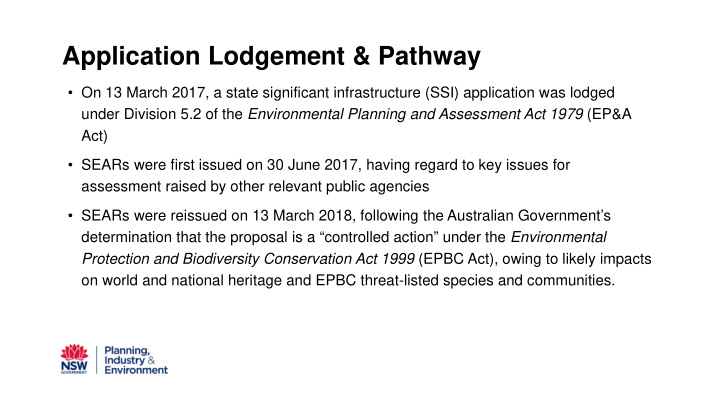



Application Lodgement & Pathway • On 13 March 2017, a state significant infrastructure (SSI) application was lodged under Division 5.2 of the Environmental Planning and Assessment Act 1979 (EP&A Act) • SEARs were first issued on 30 June 2017, having regard to key issues for assessment raised by other relevant public agencies • SEARs were reissued on 13 March 2018, following the Australian Government’s determination that the proposal is a “controlled action” under the Environmental Protection and Biodiversity Conservation Act 1999 (EPBC Act), owing to likely impacts on world and national heritage and EPBC threat-listed species and communities.
Framework for Biodiversity Assessment • The proposal will be assessed under the Framework for Biodiversity Assessment (FBA). • The FBA continues to apply to this and other proposals where an SSI application was made prior to the commencement of the Biodiversity Conservation Act 2016 , in accordance with the relevant savings and transitional arrangements. • The SEARs require assessment of upstream and downstream operation impacts, and assessment of impacts associated with construction of the wall. • The FBA is an accredited assessment approach under the Bilateral Agreement with the Australian Government.
Aboriginal cultural heritage • The SEARs require detailed assessment of impacts to Aboriginal places and objects and cultural heritage values. • The Applicant is required to conduct its assessment having regard to relevant guidelines, including the Guide to investigating, assessing and reporting on Aboriginal Cultural Heritage in NSW (OEH, 2011), Aboriginal Cultural Heritage Consultation requirements for proponents (DECCW, 2010), Code of practice for archaeological investigation of Aboriginal objects in NSW (DECCW, 2010) and consideration of Indigenous Land Use Agreements. • The Applicant is required to prepare its EIS in consultation with Registered Aboriginal Parties.
Bilateral assessment • EPBC Act contains provision for assessment of EPBC matters under accredited state processes, including the SSI pathway. • The proposal will be assessed under a Bilateral Agreement (in effect February 2015), which still applies to this proposal in accordance with transitional arrangements that accompany the recent 2020 Amending Agreement. • The Bilateral Agreement governs assessments made under the FBA. • NSW is committed under the Bilateral Agreement to undertake an assessment of matters of nationally protected matters (MNES) on behalf of the Commonwealth using accredited processes as specified in the Bilateral Agreement, including SSI projects such as this. • The Assessment Report prepared by DPIE on any Bilateral matter must provide sufficient information of impacts on nationally protected matters for the Commonwealth decision-maker to make a decision on whether or not to approve the development under the EPBC Act.
World heritage • The Greater Blue Mountains World Heritage Area is a world heritage property with Outstanding Universal Value, and the proponent must obtain approval for potential impacts on the OUV of the property under the EPBC Act. • OUV is the combined and interconnected values which collectively make the property an important place internationally. OUV is described in a ‘Statement of Outstanding Universal Value’ that is adopted by the World Heritage Committee and published. • Impacts to OUV are assessed considering the collective value of individual attributes of the property, and the integrity and management of the world heritage property, rather than as discrete components of value (e.g. heritage values, biodiversity values, indigenous heritage).
Assessing severely burnt sites • In response to the 2019/20 fires, the Department prepared a Guideline for applying the biodiversity assessment method at severely burnt sites. https://www.environment.nsw.gov.au/research-and- publications/publications-search/guideline-for-applying-biodiversity-assessment-method-at-severely-burnt- sites-assessment-reports • Provides a reasonable, evidence-based and transparent process for identifying severely burnt native vegetation and provides a range of approaches for applying the biodiversity assessment method (BAM) on land impacted by severe bushfire. • Outlines the approach to identifying the biodiversity values that existed on the land prior to severe bushfire for the purpose of preparing or finalising a biodiversity development assessment report. • Provides guidance in relation to biodiversity assessments undertaken using the BAM – however the principles for assessment bushfire impacts are also relevant to the assessment method used for the Warragamba proposal, namely FBA.
Recommend
More recommend